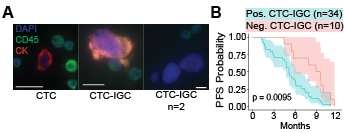Polyploid cancer cells reveal signatures of chemotherapy resistance
Published in Cancer and Genetics & Genomics

The Challenge of Therapeutic Resistance
Prostate and breast cancers, among the most common malignancies, often respond well to initial treatments. However, recurrence rates are alarmingly high [1-3]. Late-stage metastatic cancers pose an even greater challenge, with chemotherapy offering limited success [4-5]. Despite extensive research into the mechanisms of therapy resistance, it remains the cause of over 90% of cancer-related deaths and urgently needs to be addressed [6-8].
The Role of Polyploid Cancer Cells
Our study focuses on large polyploid cancer cells, which have been associated with late disease stages, poor prognosis, and therapy resistance across various cancer types [9-13]. These cells can arise in response to stressors, including chemotherapy agents like docetaxel and cisplatin [14-17]. Whole genome doubling (WGD) events that lead to polyploidy are poor prognostic indicators and may provide cancer cells with the ability to evolve and survive therapy [18-21].
Our Study: Key Findings
In our research, we analyzed bone marrow aspirates from 44 advanced prostate cancer patients. We discovered that the presence of circulating tumor cells with increased genomic content (CTC-IGC) was significantly associated with poorer progression-free survival (Figure 1).

In vitro, we examined induced polyploid cancer cells from PC3 and MDA-MB-231 cell lines treated with docetaxel or cisplatin. Through single-cell DNA sequencing, RNA sequencing, and protein immunofluorescence, we identified novel RNA and protein markers linked to chemotherapy resistance, including HOMER1, TNFRSF9, and LRP1. These markers were present in a subset of patient CTCs and are associated with recurrence in public gene expression data. We were also able to obtain a progeny clone descended from one polyploid cancer cell that retained surviving polyploid cancer cell markers.
Implications for Cancer Treatment
Our findings highlight the prognostic significance of large polyploid tumor cells and their role in chemotherapy resistance. The expression of markers tied to cancer relapse offers new potential avenues for therapeutic development. By targeting these markers, we may improve treatment outcomes and reduce recurrence rates.
Future Directions
While our study provides valuable insights, it also raises important questions. The presence of polyploid cancer cells in late-stage disease suggests a need for further research into their role in early-stage cancers. Additionally, understanding how these cells interact with their environment and other cancer cells could provide new therapeutic targets.
Future studies should explore the roles of identified markers like TNFRSF9, HOMER1, and LRP1 in chemotherapy resistance. Investigating these markers in vivo, using mouse models or patient-derived xenografts, will be crucial in translating our findings into clinical applications.
Conclusion
Our research underscores the importance of understanding the role of polyploid cancer cells in therapy resistance and disease recurrence. By identifying novel biomarkers and potential therapeutic targets, we hope to pave the way for more effective cancer treatments. Theoretically, it only takes one polyploid cancer cell to initiate relapse. As we continue to unravel the complexities of cancer biology, understanding and combating the mechanisms of resistance these cells utilize will aid in deconvoluting therapy resistance.
References
- Kurbegovic, S., et al.: The risk of biochemical recurrence for intermediate-risk prostate cancer after radical prostatectomy. Scand J Urol 51, 450-6 (2017)
- Goss, P.E., et al.: Extending aromatase-inhibitor adjuvant therapy to 10 years. N Engl J Med 375, 209-19 (2016)
- Colleoni, M., et al.: Annual hazard rates of recurrence for breast cancer during 24 years of follow-up: Results from the international breast cancer study group trials i to v. J Clin Oncol 34, 927-35 (2016)
- Bukowski, K., et al.: Mechanisms of multidrug resistance in cancer chemotherapy. Int J Mol Sci 21 (2020)
- Ashdown, M.L., et al.: Chemotherapy for late-stage cancer patients: Meta-analysis of complete response rates. F1000Res 4, 232 (2015)
- Wang, X., et al.: Drug resistance and combating drug resistance in cancer. Cancer Drug Resist 2, 141-60 (2019)
- Cree, I.A., et al.: Molecular chess? hallmarks of anti-cancer drug resistance. BMC Cancer 17, 10 (2017)
- Siegel, R.L., et al.: Cancer statistics, 2023. CA Cancer J Clin 73, 17-48 (2023)
- Trabzonlu, L., et al.: Presence of cells in the polyaneuploid cancer cell (pacc) state predicts the risk of recurrence in prostate cancer. Prostate 83, 277-85 (2023)
- Fei, F., et al.: The number of polyploid giant cancer cells and epithelial-mesenchymal transition-related proteins are associated with invasion and metastasis in human breast cancer. J Exp Clin Cancer Res 34, 158 (2015)
- Amend, S.R., et al.: Polyploid giant cancer cells: Unrecognized actuators of tumorigenesis, metastasis, and resistance. Prostate 79, 1489-97 (2019)
- Lopez-Sanchez, L.M., et al.: Cocl2, a mimic of hypoxia, induces formation of polyploid giant cells with stem characteristics in colon cancer. PLoS One 9, 99143 (2014)
- Was, H., et al.: Polyploidy formation in cancer cells: How a trojan horse is born. Semin Cancer Biol 81, 24-36 (2022)
- Saleh, T., et al.: Targeting tumor cell senescence and polyploidy as potential therapeutic strategies. Semin Cancer Biol 81, 37-47 (2022)
- Ogden, A., et al.: Docetaxel-induced polyploidization may underlie chemoresistance and disease relapse. Cancer Lett 367, 89-92 (2015)
- Puig, P.-E., et al.: Tumor cells can escape dna-damaging cisplatin through dna endoreduplication and reversible polyploidy. Cell Biol Int 32, 103-43 (2008)
- Adibi, R., et al.: Zoledronic acid targets chemo-resistant polyploid giant cancer cells. Sci Rep 13, 419 (2023)
- Bielski, C.M., et al.: Genome doubling shapes the evolution and prognosis of advanced cancers. Nat Genet 50, 1189-95 (2018)
- Lopez, S., et al.: Interplay between whole-genome doubling and the accumulation of deleterious alterations in cancer evolution. Nat Genet 52, 283-93 (2020)
- Pienta, K.J., et al.: Cancer cells employ an evolutionarily conserved polyploidization program to resist therapy. Semin Cancer Biol 81, 145-59 (2022)
- Pienta, K.J., et al.: Polyaneuploid cancer cells promote evolvability, generating lethal cancer. Evol Appl 13, 1626-34 (2020)
Follow the Topic
-
Oncogene

This journal aims to make substantial advances in our knowledge of processes that contribute to cancer by publishing outstanding research.





Please sign in or register for FREE
If you are a registered user on Research Communities by Springer Nature, please sign in